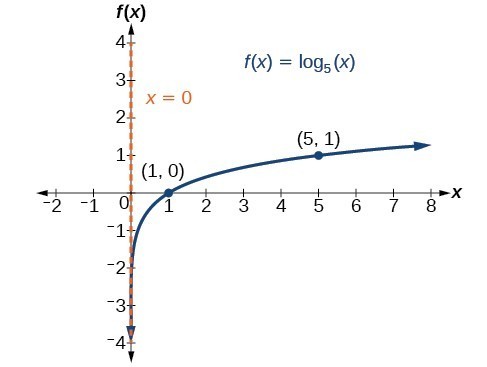Learning Outcomes
- Evaluate logarithmic expressions using the definition of logarithms.
- Graph logarithmic functions by creating a table of values.
- Find the equation of the asymptote for a logarithmic function.
- Find the domain and range of a logarithmic function using its graph and write them in interval notation.
- Rewrite exponential equations in logarithmic form.
- Rewrite logarithmic equations in exponential form.

Devastation of the earthquake which happened on March 11, 2011 in Honshu, Japan. (credit: Daniel Pierce)
In [latex]2010[/latex], a major earthquake struck Haiti, destroying or damaging over [latex]285,000[/latex] homes.[1] One year later, another, stronger earthquake devastated Honshu, Japan, destroying or damaging over [latex]332,000[/latex] buildings,[2] like those shown in the picture above. Even though both caused substantial damage, the earthquake in [latex]2011[/latex] was [latex]100[/latex] times stronger than the earthquake in Haiti. How do we know? The magnitudes of earthquakes are measured on a scale known as the Richter Scale. The Haitian earthquake registered a [latex]7.0[/latex] on the Richter Scale[3] whereas the Japanese earthquake registered a [latex]9.0[/latex].[4]
The Richter Scale is a base-ten logarithmic scale. In other words, an earthquake of magnitude 8 is not twice as great as an earthquake of magnitude [latex]4[/latex]. It is [latex]{10}^{8 - 4}={10}^{4}=10,000[/latex] times as great! In this lesson, we will investigate the nature of the Richter Scale and the base-ten function upon which it depends.
In order to analyze the magnitude of earthquakes or compare the magnitudes of two different earthquakes, we need to be able to convert between logarithmic and exponential form. For example, suppose the amount of energy released from one earthquake were [latex]500[/latex] times greater than the amount of energy released from another. We want to calculate the difference in magnitude. The equation that represents this problem is [latex]{10}^{x}=500[/latex], where [latex]x[/latex] represents the difference in magnitudes on the Richter Scale. How would we solve for [latex]x[/latex]?
We have not yet learned a method for solving exponential equations. None of the algebraic tools discussed so far is sufficient to solve [latex]{10}^{x}=500[/latex]. We know that [latex]{10}^{2}=100[/latex] and [latex]{10}^{3}=1000[/latex], so it is clear that [latex]x[/latex] must be some value between [latex]2[/latex] and [latex]3[/latex], since [latex]y={10}^{x}[/latex] is increasing. We can examine a graph to better estimate the solution.
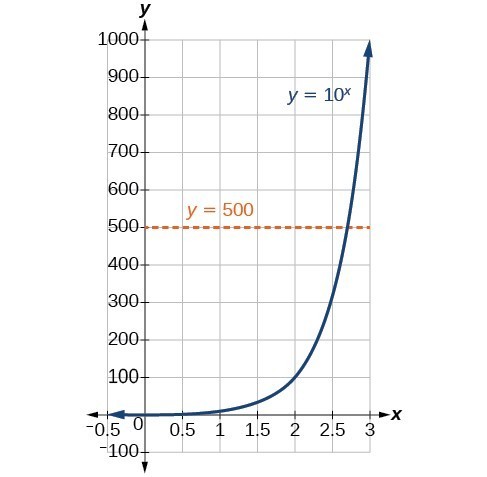
Estimating from a graph, however, is imprecise. To find an algebraic solution, we must introduce a new function. Observe that the graph above passes the horizontal line test. The exponential function [latex]y={b}^{x}[/latex] is one-to-one, so its inverse, [latex]x={b}^{y}[/latex] is also a function. As is the case with all inverse functions, we simply interchange x and y and solve for y to find the inverse function. To represent y as a function of x, we use a logarithmic function of the form [latex]y={\mathrm{log}}_{b}\left(x\right)[/latex]. The base b logarithm of a number is the exponent by which we must raise b to get that number.
We read a logarithmic expression as, “The logarithm with base b of x is equal to y,” or, simplified, “log base b of x is y.” We can also say, “b raised to the power of y is x,” because logs are exponents. For example, the base [latex]2[/latex] logarithm of [latex]32[/latex] is [latex]5[/latex], because [latex]5[/latex] is the exponent we must apply to [latex]2[/latex] to get [latex]32[/latex]. Since [latex]{2}^{5}=32[/latex], we can write [latex]{\mathrm{log}}_{2}32=5[/latex]. We read this as “log base [latex]2[/latex] of [latex]32[/latex] is [latex]5[/latex].”
We can express the relationship between logarithmic form and its corresponding exponential form as follows:
Note that the base b is always positive.

Because logarithms are functions, they are most correctly written as [latex]{\mathrm{log}}_{b}\left(x\right)[/latex], using parentheses to denote function evaluation, just as we would with [latex]f\left(x\right)[/latex]. However, when the input is a single variable or number, it is common to see the parentheses dropped and the expression written without parentheses, as [latex]{\mathrm{log}}_{b}x[/latex]. Note that many calculators require parentheses around the x.
We can illustrate the notation of logarithms as follows:

Notice that, comparing the logarithm function and the exponential function, the input and the output are switched. This means [latex]y={\mathrm{log}}_{b}\left(x\right)[/latex] and [latex]y={b}^{x}[/latex] are inverse functions.
Definition of the Logarithmic Function
A logarithm base b of a positive number x satisfies the following definition.
For [latex]x>0,b>0,b\ne 1[/latex],
where
- we read [latex]{\mathrm{log}}_{b}\left(x\right)[/latex] as, “the logarithm with base b of x” or the “log base b of x.”
- the logarithm y is the exponent to which b must be raised to get x.
Also, since the logarithmic and exponential functions switch the x and y values, the domain and range of the exponential function are interchanged for the logarithmic function. Therefore,
- the domain of the logarithm function with base [latex]b \text{ is} \left(0,\infty \right)[/latex].
- the range of the logarithm function with base [latex]b \text{ is} \left(-\infty ,\infty \right)[/latex].
In our first example, we will convert logarithmic equations into exponential equations.
Example
Write the following logarithmic equations in exponential form.
- [latex]{\mathrm{log}}_{6}\left(\sqrt{6}\right)=\frac{1}{2}[/latex]
- [latex]{\mathrm{log}}_{3}\left(9\right)=2[/latex]
Show Solution
In the following video, we present more examples of rewriting logarithmic equations as exponential equations.
How To: Given an equation in logarithmic form [latex]{\mathrm{log}}_{b}\left(x\right)=y[/latex], convert it to exponential form
- Examine the equation [latex]y={\mathrm{log}}_{b}x[/latex] and identify b, y, and x.
- Rewrite [latex]{\mathrm{log}}_{b}x=y[/latex] as [latex]{b}^{y}=x[/latex].
Think About It
Can we take the logarithm of a negative number? Re-read the definition of a logarithm and formulate an answer. Think about the behavior of exponents. You can use the textbox below to formulate your ideas before you look at an answer.
Knowing the squares, cubes, and roots of numbers allows us to evaluate many logarithms mentally. For example, consider [latex]{\mathrm{log}}_{2}8[/latex]. We ask, “To what exponent must [latex]2[/latex] be raised in order to get [latex]8[/latex]?” Because we already know [latex]{2}^{3}=8[/latex], it follows that [latex]{\mathrm{log}}_{2}8=3[/latex].
Now consider solving [latex]{\mathrm{log}}_{7}49[/latex] and [latex]{\mathrm{log}}_{3}27[/latex] mentally.
- We ask, “To what exponent must [latex]7[/latex] be raised in order to get [latex]49[/latex]?” We know [latex]{7}^{2}=49[/latex]. Therefore, [latex]{\mathrm{log}}_{7}49=2[/latex]
- We ask, “To what exponent must [latex]3[/latex] be raised in order to get [latex]27[/latex]?” We know [latex]{3}^{3}=27[/latex]. Therefore, [latex]{\mathrm{log}}_{3}27=3[/latex]
Even some seemingly more complicated logarithms can be evaluated without a calculator. For example, let us evaluate [latex]{\mathrm{log}}_{\frac{2}{3}}\frac{4}{9}[/latex] mentally.
- We ask, “To what exponent must [latex]\frac{2}{3}[/latex] be raised in order to get [latex]\frac{4}{9}[/latex]? ” We know [latex]{2}^{2}=4[/latex] and [latex]{3}^{2}=9[/latex], so [latex]{\left(\frac{2}{3}\right)}^{2}=\frac{4}{9}[/latex]. Therefore, [latex]{\mathrm{log}}_{\frac{2}{3}}\left(\frac{4}{9}\right)=2[/latex].
In our first example, we will evaluate logarithms mentally.
Example
Solve [latex]y={\mathrm{log}}_{4}\left(64\right)[/latex] without using a calculator.
In our first video, we will show more examples of evaluating logarithms mentally; this helps you get familiar with what a logarithm represents.
In our next example, we will evaluate the logarithm of a reciprocal.
Example
Evaluate [latex]y={\mathrm{log}}_{3}\left(\frac{1}{27}\right)[/latex] without using a calculator.
How To: Given a logarithm of the form [latex]y={\mathrm{log}}_{b}\left(x\right)[/latex], evaluate it mentally
- Rewrite the argument x as a power of b: [latex]{b}^{y}=x[/latex].
- Use previous knowledge of powers of b to identify y by asking, “To what exponent should b be raised in order to get x?”
Convert from Exponential to Logarithmic Form
To convert from exponential form to logarithmic form, we follow the same steps in reverse. We identify the base b, exponent x, and output y. Then we write [latex]x={\mathrm{log}}_{b}\left(y\right)[/latex].
Example
Write the following exponential equations in logarithmic form.
- [latex]{2}^{3}=8[/latex]
- [latex]{5}^{2}=25[/latex]
- [latex]{10}^{-4}=\frac{1}{10,000}[/latex]
In our last video, we show more examples of writing logarithmic equations as exponential equations.
Summary
The base b logarithm of a number is the exponent by which we must raise b to get that number. Logarithmic functions are the inverse of exponential functions, and it is often easier to understand them through this lens. We can never take the logarithm of a negative number, therefore [latex]{\mathrm{log}}_{b}\left(x\right)=y[/latex] is defined for [latex]b>0[/latex]
Before working with graphs, we will take a look at the domain (the set of input values) for which the logarithmic function is defined.
Recall that the exponential function is defined as [latex]y={b}^{x}[/latex] for any real number x and constant [latex]b>0[/latex], [latex]b\ne 1[/latex], where
- The domain of is [latex]\left(-\infty ,\infty \right)[/latex].
- The range of is [latex]\left(0,\infty \right)[/latex].
In the last section we learned that the logarithmic function [latex]y={\mathrm{log}}_{b}\left(x\right)[/latex] is the inverse of the exponential function [latex]y={b}^{x}[/latex]. So, as inverse functions:
- The domain of [latex]y={\mathrm{log}}_{b}\left(x\right)[/latex] is the range of [latex]y={b}^{x}[/latex]: [latex]\left(0,\infty \right)[/latex].
- The range of [latex]y={\mathrm{log}}_{b}\left(x\right)[/latex] is the domain of [latex]y={b}^{x}[/latex]: [latex]\left(-\infty ,\infty \right)[/latex].
How To: Given a logarithmic function, identify the domain
- Set up an inequality showing the argument greater than zero.
- Solve for x.
- Write the domain in interval notation.
In our first example, we will show how to identify the domain of a logarithmic function.
Example
What is the domain of [latex]f\left(x\right)={\mathrm{log}}_{2}\left(x+3\right)[/latex]?
Here is another example of how to identify the domain of a logarithmic function.
Example
What is the domain of [latex]f\left(x\right)=\mathrm{log}\left(5 - 2x\right)[/latex]?
Graph Logarithmic Functions
Creating a graphical representation of most functions gives us another layer of insight for predicting future events. How do logarithmic graphs give us insight into situations? Because every logarithmic function is the inverse function of an exponential function, we can think of every output on a logarithmic graph as the input for the corresponding inverse exponential equation. In other words, logarithms give the cause for an effect.
To illustrate, suppose we invest $2500 in an account that offers an annual interest rate of [latex]5\%[/latex], compounded continuously. We already know that the balance in our account for any year t can be found with the equation [latex]A=2500{e}^{0.05t}[/latex].
But what if we wanted to know the year for any balance? We would need to create a corresponding new function by interchanging the input and the output; thus we would need to create a logarithmic model for this situation. By graphing the model, we can see the output (year) for any input (account balance). For instance, what if we wanted to know how many years it would take for our initial investment to double? The image below shows this point on the logarithmic graph.
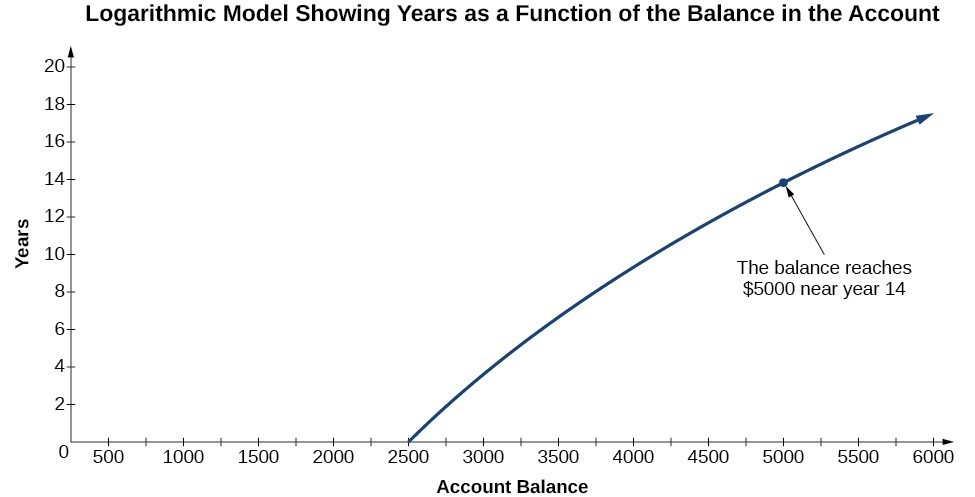
A logarithmic graph showing how many years it will take for an account balance to double.
Now that we have a feel for the set of values for which a logarithmic function is defined, we move on to graphing logarithmic functions. The family of logarithmic functions includes the parent function [latex]y={\mathrm{log}}_{b}\left(x\right)[/latex] along with all its transformations: shifts, stretches, compressions, and reflections.
We begin with the parent function [latex]y={\mathrm{log}}_{b}\left(x\right)[/latex]. Because every logarithmic function of this form is the inverse of an exponential function of the form [latex]y={b}^{x}[/latex], their graphs will be reflections of each other across the line [latex]y=x[/latex]. To illustrate this, we can observe the relationship between the input and output values of [latex]y={2}^{x}[/latex] and its equivalent [latex]x={\mathrm{log}}_{2}\left(y\right)[/latex] in the table below.
| x | [latex]–3[/latex] | [latex]–2[/latex] | [latex]–1[/latex] | [latex]0[/latex] | [latex]1[/latex] | [latex]2[/latex] | [latex]3[/latex] |
| [latex]{2}^{x}=y[/latex] | [latex]\frac{1}{8}[/latex] | [latex]\frac{1}{4}[/latex] | [latex]\frac{1}{2}[/latex] | [latex]1[/latex] | [latex]2[/latex] | [latex]4[/latex] | [latex]8[/latex] |
| [latex]{\mathrm{log}}_{2}\left(y\right)=x[/latex] | [latex]–3[/latex] | [latex]–2[/latex] | [latex]–1[/latex] | [latex]0[/latex] | [latex]1[/latex] | [latex]2[/latex] | [latex]3[/latex] |
Using the inputs and outputs from the table above, we can build another table to observe the relationship between points on the graphs of the inverse functions [latex]f\left(x\right)={2}^{x}[/latex] and [latex]g\left(x\right)={\mathrm{log}}_{2}\left(x\right)[/latex].
| [latex]f\left(x\right)={2}^{x}[/latex] | [latex]\left(-3,\frac{1}{8}\right)[/latex] | [latex]\left(-2,\frac{1}{4}\right)[/latex] | [latex]\left(-1,\frac{1}{2}\right)[/latex] | [latex]\left(0,1\right)[/latex] | [latex]\left(1,2\right)[/latex] | [latex]\left(2,4\right)[/latex] | [latex]\left(3,8\right)[/latex] |
| [latex]g\left(x\right)={\mathrm{log}}_{2}\left(x\right)[/latex] | [latex]\left(\frac{1}{8},-3\right)[/latex] | [latex]\left(\frac{1}{4},-2\right)[/latex] | [latex]\left(\frac{1}{2},-1\right)[/latex] | [latex]\left(1,0\right)[/latex] | [latex]\left(2,1\right)[/latex] | [latex]\left(4,2\right)[/latex] | [latex]\left(8,3\right)[/latex] |
As we would expect, the x– and y-coordinates are reversed for the inverse functions. The figure below shows the graph of f and g.
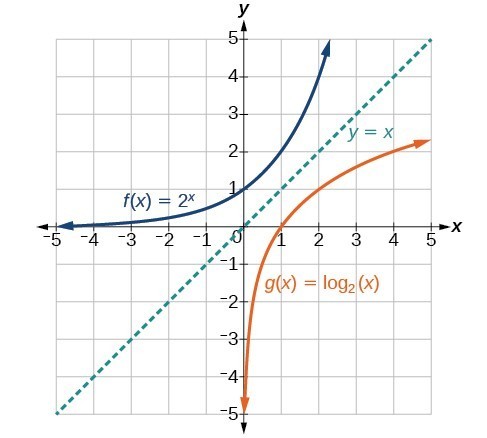
Notice that the graphs of [latex]f\left(x\right)={2}^{x}[/latex] and [latex]g\left(x\right)={\mathrm{log}}_{2}\left(x\right)[/latex] are reflections about the line y = x.
Observe the following from the graph:
- [latex]f\left(x\right)={2}^{x}[/latex] has a y-intercept at [latex]\left(0,1\right)[/latex] and [latex]g\left(x\right)={\mathrm{log}}_{2}\left(x\right)[/latex] has an x-intercept at [latex]\left(1,0\right)[/latex].
- The domain of [latex]f\left(x\right)={2}^{x}[/latex], [latex]\left(-\infty ,\infty \right)[/latex], is the same as the range of [latex]g\left(x\right)={\mathrm{log}}_{2}\left(x\right)[/latex].
- The range of [latex]f\left(x\right)={2}^{x}[/latex], [latex]\left(0,\infty \right)[/latex], is the same as the domain of [latex]g\left(x\right)={\mathrm{log}}_{2}\left(x\right)[/latex].
A General Note: Characteristics of the Graph of the Parent Function, f(x) = logb(x)
For any real number x and constant b > 0, [latex]b\ne 1[/latex], we can see the following characteristics in the graph of [latex]f\left(x\right)={\mathrm{log}}_{b}\left(x\right)[/latex]:
- one-to-one function
- vertical asymptote: x =[latex]0[/latex]
- domain: [latex]\left(0,\infty \right)[/latex]
- range: [latex]\left(-\infty ,\infty \right)[/latex]
- x-intercept: [latex]\left(1,0\right)[/latex] and key point [latex]\left(b,1\right)[/latex]
- y-intercept: none
- increasing if [latex]b>1[/latex]
- decreasing if [latex]0 \lt b \lt 1[/latex]
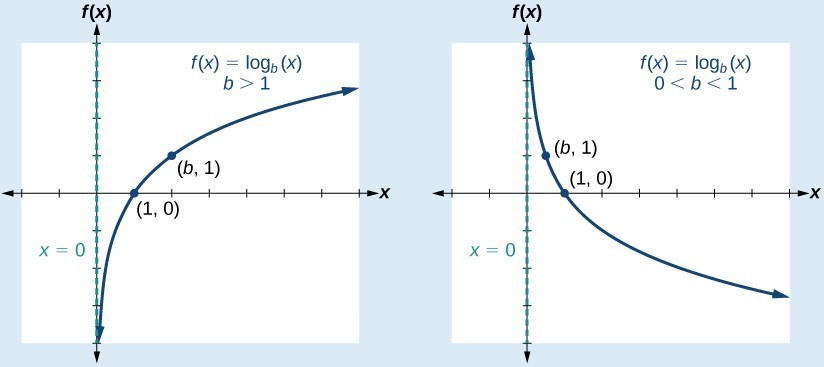
The figure below shows how changing the base b in [latex]f\left(x\right)={\mathrm{log}}_{b}\left(x\right)[/latex] can affect the graphs. Observe that the graphs compress vertically as the value of the base increases. (Note: recall that the function [latex]\mathrm{ln}\left(x\right)[/latex] has base [latex]e\approx \text{2}.\text{718.)}[/latex]

The graphs of three logarithmic functions with different bases, all greater than 1.
In our next example, we will graph a logarithmic function of the form [latex]f\left(x\right)={\mathrm{log}}_{b}\left(x\right)[/latex].
Example
Graph [latex]f\left(x\right)={\mathrm{log}}_{5}\left(x\right)[/latex]. State the domain and range.
How To: Given a logarithmic function of the form [latex]f\left(x\right)={\mathrm{log}}_{b}\left(x\right)[/latex], graph the function
- Plot the x-intercept, [latex]\left(1,0\right)[/latex].
- Plot the key point [latex]\left(b,1\right)[/latex].
- Draw a smooth curve through the points.
- State the domain, [latex]\left(0,\infty \right)[/latex], and the range, [latex]\left(-\infty ,\infty \right)[/latex].
Summary
To define the domain of a logarithmic function algebraically, set the argument greater than zero and solve. To plot a logarithmic function, it is easiest to find and plot the x-intercept and the key point [latex]\left(b,1\right)[/latex].
Candela Citations
- Ex: Write Exponential Equations as Logarithmic Equations. Authored by: James Sousa (Mathispower4u.com) for Lumen Learning. Located at: https://youtu.be/9_GPPUWEJQQ. License: CC BY: Attribution
- Revision and Adaptation. Provided by: Lumen Learning. License: CC BY: Attribution
- Precalculus. Authored by: Jay Abramson, et al.. Provided by: OpenStax. Located at: http://cnx.org/contents/fd53eae1-fa23-47c7-bb1b-972349835c3c@5.175. License: CC BY: Attribution. License Terms: Download For Free at : http://cnx.org/contents/fd53eae1-fa23-47c7-bb1b-972349835c3c@5.175.
- Ex: Write Logarithmic Equations as Exponential Equations. Authored by: James Sousa (Mathispower4u.com) for Lumen Learning. Located at: https://youtu.be/q9_s0wqhIXU. License: CC BY: Attribution
- http://earthquake.usgs.gov/earthquakes/eqinthenews/2010/us2010rja6/#summary. Accessed [latex]3/4/2013[/latex]. ↵
- http://earthquake.usgs.gov/earthquakes/eqinthenews/2011/usc0001xgp/#summary. Accessed [latex]3/4/2013[/latex]. ↵
- http://earthquake.usgs.gov/earthquakes/eqinthenews/2010/us2010rja6/. Accessed [latex]3/4/2013[/latex]. ↵
- http://earthquake.usgs.gov/earthquakes/eqinthenews/2011/usc0001xgp/#details. Accessed [latex]3/4/2013[/latex]. ↵
